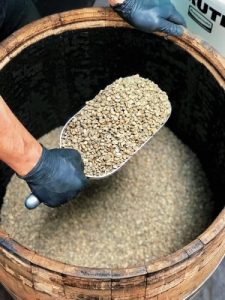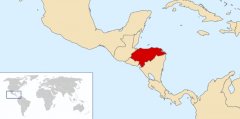Indonesian mantenin coffee bean type aged coffee bean production method can drink it? monsoon treatment
Most people think of Manning when they hear Indonesian coffee. But you know what? Manning coffee also has many kinds of coffee beans. In front of the street, there are gold manning, tiger manning and old manning. Next, I will introduce you one by one.
Let's start by introducing you to the old Manning. Usually translated as Old Sumatra, it is a rich and complex "spice box" with strong wine aromas and apparently nuanced aromas that convey senses.

The old Manning originated from European trade. Businessmen often export coffee from Africa, later India and Indonesia. As early as the 1500's, the only way to transport coffee was by long voyage. It may take more than a month to get around the Cape of good Hope, as the sea breeze and transportation time change the taste of the coffee. Europeans are used to drinking coffee that has been aged for at least a few months. Even after the Suez Canal shortened the journey, most Europeans still prefer old coffee to fresh coffee. So the product of the old Manning came into being. To satisfy customers' preferences, merchants replicate the impact of sea travel on coffee by storing coffee beans in coastal warehouses for months before shipment. This method is for coffee to be aged in the first place. The best aged coffee is low-sour coffee beans from India and Indonesia.

Aged Sumatran and Sulawesi coffee have a unique spicy flavor. India has its own specific variety of aged coffee, Monsooned Malabar, which is famous for its chocolate flavor. Monsooned Malabar originates from the old coffee exported to Europe by the British in India. A sea journey from India usually takes several months, and once the coffee arrives, people begin to realize that coffee transported during the monsoon season has a different flavor and appearance from coffee shipped at other times of the year.
The combination of moisture and sea breeze causes the beans to swell slightly and turn yellow. They also lost all their acidity and made a thick, earthy cup. After more effective sea travel, legumes are no longer exposed to the elements that cause them to develop in a unique way. To make up for this, coffee beans are aged in warehouses and exposed to monsoons for three to four months. Monsoon Malabar is now protected by commodity geographical indications, which means it can only be produced in India-especially along the Malabar coast. Not all aged coffee has the same strict standards as the monsoon Malabar, but there is a difference between aged coffee and aged coffee. Aged coffee must be stored in a well-ventilated warehouse. Every few months, the bags are checked and rotated to dry them. In order to age properly, coffee needs a climate so that coffee beans can absorb water during the rainy season and release water during the dry season. This is part of the reason why most high-quality aged coffee comes from Indonesia, India and South America. Coffee tends to be mellow as it ages, so varieties that start with low acidity usually age well.

Barreled coffee is a variant that is usually used by people who do not have room to lay it flat. There is a new market for whisky aged coffee: coffee that used to be aged in buckets of whisky or bourbon. This kind of coffee has obviously acquired a series of new flavors.
But it's worth noting that aged coffee is usually kept for months to years, depending on its variety or what the roaster thinks. Aged Sumatran coffee is usually aged for three to five years, while some barrels of aged coffee are retained for only a month and a half. If not stored properly, the coffee beans may go bad and lose their taste.
Important Notice :
前街咖啡 FrontStreet Coffee has moved to new addredd:
FrontStreet Coffee Address: 315,Donghua East Road,GuangZhou
Tel:020 38364473
- Prev

Mantening coffee the correct brewing method authentic Indonesian coffee should be how to drink it can be added milk?
How should I drink my coffee? There are often customers who say they can't understand the flavor of Mantenin, complain about the mellow flavor of Manning coffee, and bitter chocolate has the taste of some herbs. Then Qianjie will show you how traditional Indonesians drink coffee since it was first introduced in the 17th and 18th centuries.
- Next

Six major coffee producing areas of Central America and Honduras Litchi Orchid Coffee Flavor introduces how to make it good?
The origin and flavor of Honduran coffee made him shine in the coffee industry. Unlike Brazilian coffee, Colombian coffee and Costa Rican coffee in Central America, Honduran coffee is a rising star. So let's take a look at six different regions of Honduran coffee. Copan is located in western Honduras and borders Guatemala, including Copan, Ocotepek and
Related
- Detailed explanation of Jadeite planting Land in Panamanian Jadeite Manor introduction to the grading system of Jadeite competitive bidding, Red bid, Green bid and Rose Summer
- Story of Coffee planting in Brenka region of Costa Rica Stonehenge Manor anaerobic heavy honey treatment of flavor mouth
- What's on the barrel of Blue Mountain Coffee beans?
- Can American coffee also pull flowers? How to use hot American style to pull out a good-looking pattern?
- Can you make a cold extract with coffee beans? What is the right proportion for cold-extracted coffee formula?
- Indonesian PWN Gold Mandrine Coffee Origin Features Flavor How to Chong? Mandolin coffee is American.
- A brief introduction to the flavor characteristics of Brazilian yellow bourbon coffee beans
- What is the effect of different water quality on the flavor of cold-extracted coffee? What kind of water is best for brewing coffee?
- Why do you think of Rose Summer whenever you mention Panamanian coffee?
- Introduction to the characteristics of authentic blue mountain coffee bean producing areas? What is the CIB Coffee Authority in Jamaica?

